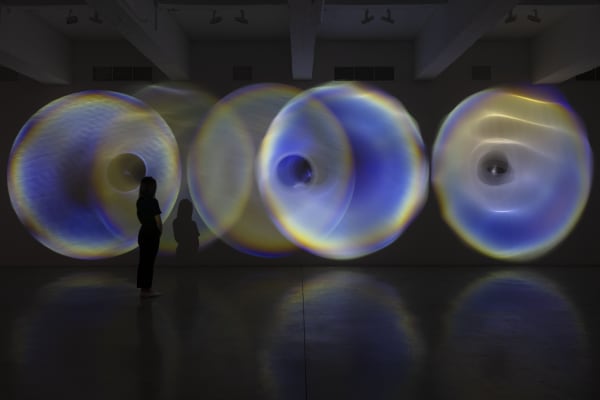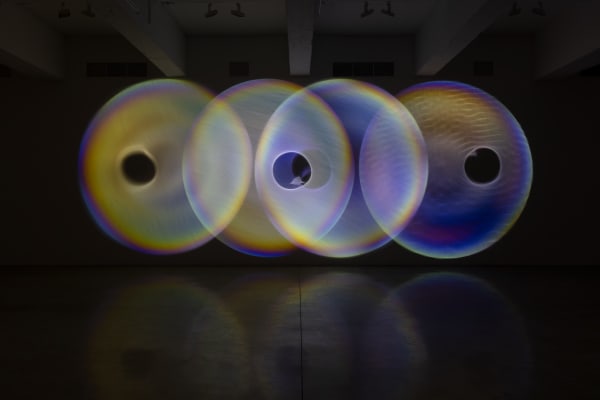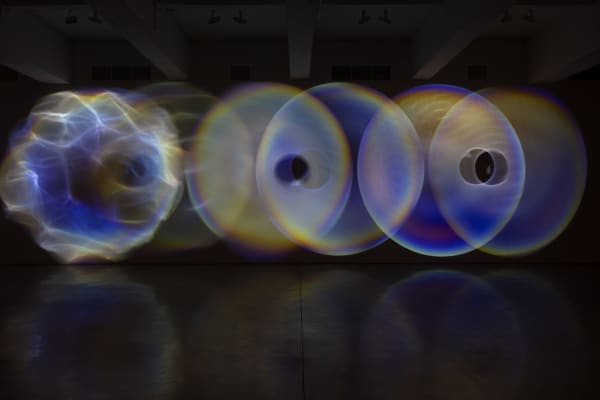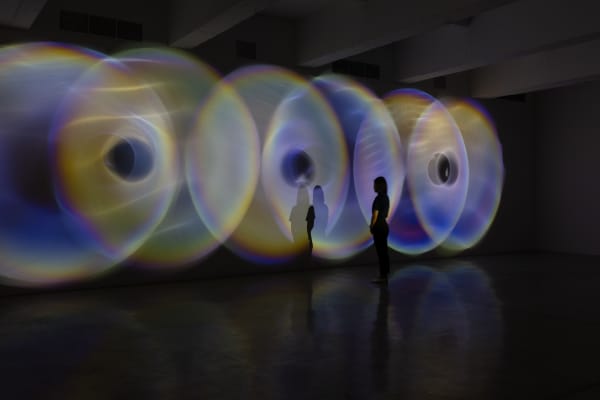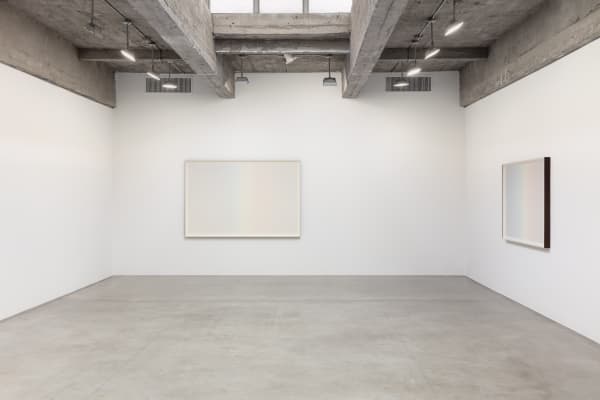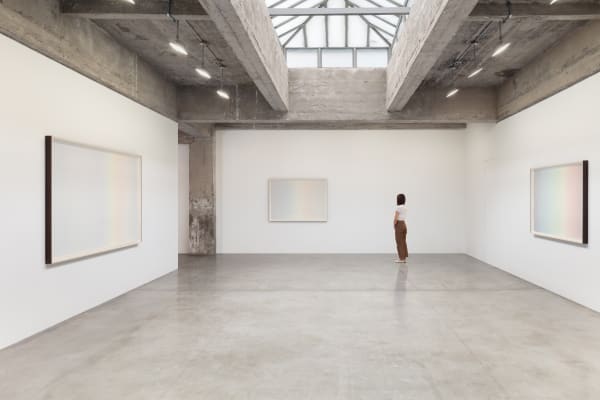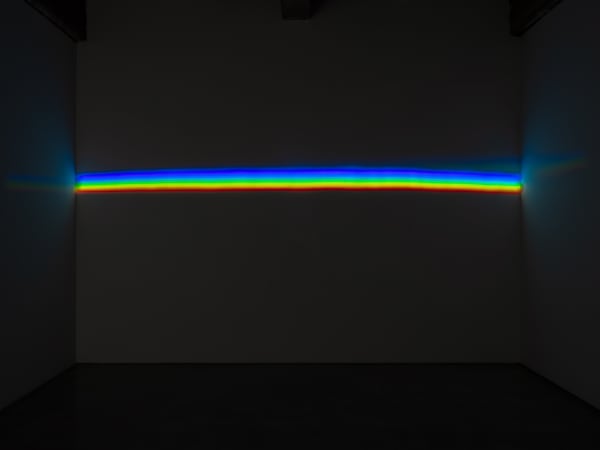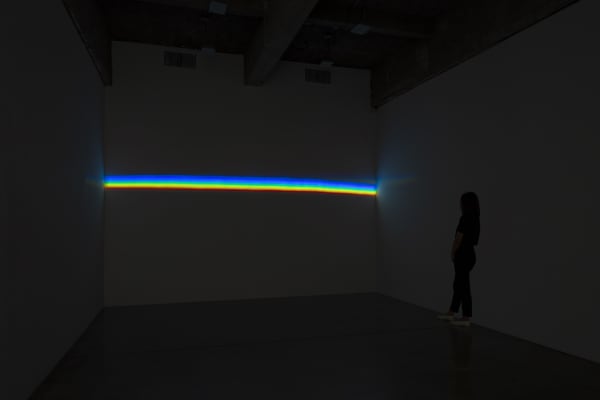Olafur Eliasson: Your psychoacoustic light ensemble: Tanya Bonakdar Gallery, New York
Tanya Bonakdar Gallery is very pleased to present a solo exhibition of new work by Icelandic-Danish artist Olafur Eliasson, on view in New York from October 24 to December 19, 2024. The exhibition will comprise two new light installations, one of which includes sound; a series of recent watercolors; and two new sculptural works. All of the works draw on Eliasson’s interest in the relativity of our perception and exploring how our experiences of the world are created.
The installation on the ground floor translates audio waves into visual phenomena. Exploring the peripheries of our perception, Eliasson employs low-frequency vibrations to create a spatial soundscape that is felt and seen, as well as heard. On the wall of a darkened room, circles of light fade in and out in reaction to a composition of sounds, while ripples of light crisscross the glowing discs. These projection works are the result of unassuming apparatuses that, as is often the case in Eliasson’s works, are left visible to the viewers. The fleeting patterns of light that dance across the projections react to the changing wavelengths of the soundwaves. Through the projected circles, the sound becomes visible, inviting viewers to see sound and hear the light—to "see" themselves hearing.
At the entry of the exhibition space hangs the glowing form of Fierce tenderness sphere. Two frames trace the geodesic lines of a sphere in opposite directions, with innumerable triangles of colored glass and color-effect filter glass affixed in pairs. These curving lines naturally draw the eye upward in a whirlwind of color and form, and even the slightest movement by the viewer alters the perceived alignment of spirals and triangles, conjuring an illusion of constant change.
The works on the second floor continue Eliasson’s investigation of color phenomena, a central concern for much of his work across all media, from large-scale installations to photographs, sculptures, and light projections. The artist is fascinated by the relativity of color perception, by the fact that how we see colors is extremely individual and dependent upon context. “Color,” he writes, “does not exist in itself but only when looked at. The unique fact that color only materializes when light bounces off a surface onto our retinas shows us that the analysis of colors is, in fact, about the ability to analyze ourselves.”
In the main sky lit gallery, the artist presents large watercolor works that conjure the evanescent luminosity of a rainbow on paper. The illusion of light, long a desiderata of painters in Western art history, is here the result of applying thin, translucent layers of pigment in succession, with a precision of execution that creates a completely seamless transition through the color spectrum. The pristine, vaporous rainbow seems to emanate from the paper, the large scale enveloping the viewer in color.
In the adjacent entry gallery, a columnar sculpture of five polyhedrons hangs to a point just above the ground. The forms in this work are Platonic solids, the only geometrical forms that can be produced using identical, regular polygons for faces. Half of each polyhedron is constructed from colored glass panels, and the other half formed from panels of mirror with the black back side facing outwards. Here, the colors correspond not to the rainbow but to the primary tones of the subtractive color model commonly used in printing: cyan, yellow, and magenta. Where the panels overlap, they mix to form a surprising range of colors, compounded by the reflections in the mirrors.
In a darkened gallery, a projection work features a single band of light containing all the colors of the visible spectrum. In nature, rainbows result from sunlight hitting water droplets at a 42-degree angle; in contrast, this artwork was produced by shining a bright white light on a prismatic arc. The clarity and intensity of the colors created are seldom seen in naturally occurring rainbows. The line of light cuts straight across the room at the artist’s eye level. For over three decades, Eliasson has been fascinated with the concept of the horizon line as a subjective experience, a line that appears consistently at your eye level and stretches around you in all directions infinitely.
Currently, Eliasson has a major solo show at The Geffen Contemporary at MOCA, Los Angeles, titled Olafur Eliasson: OPEN. Presented as part of the Getty initiative PST ART: Art & Science Collide, this exhibition will be on view through July 6, 2025. Olafur Eliasson: Your unexpected encounter is on view at the Istanbul Modern through February 9, 2025. And finally, Olafur Eliasson: Your curious journey represents the artist’s first major touring survey through the Asia Pacific region, originating at the Singapore Art Museum (May 10— September 22, 2024) and touring to Auckland Art Gallery, New Zealand (December 7, 2024—March 23, 2025); Taipei Fine Arts Museum, Taiwan (June 22—September 21, 2025); Museum MACAN, Jakarta, Indonesia (November 2025—April 2026); and the Museum of Contemporary Art and Design, Manila, the Philippines (June—October 2026).
Photo by Pierre Le Hors

